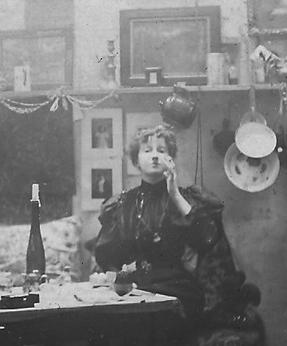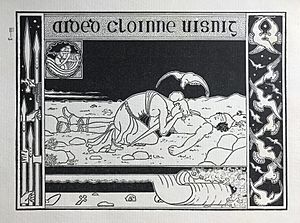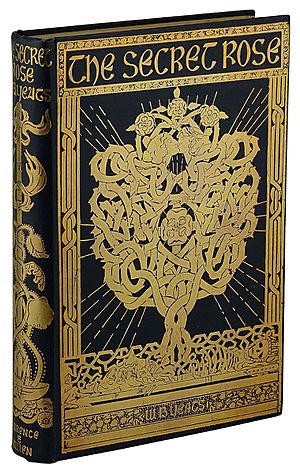Althea Gyles facts for kids
Quick facts for kids
Althea Gyles
|
|
|---|---|

Althea Gyles, about 1902
|
|
| Born |
Margaret Alethea Gyles
January 1867 Bath, Somerset, England
|
| Died | 23 January 1949 (aged 80–81) Beckenham, London
|
| Nationality | Irish |
| Known for | book design and poetry |
Althea Gyles (born January 1867, died January 23, 1949) was a talented artist and poet from Ireland. She is especially known for creating beautiful book cover designs. Some of her famous designs were for books by the well-known writer W. B. Yeats.
Contents
Early Life and Artistic Beginnings
Margaret Alithea Gyles was born in Bath, Somerset, England, in January 1867. Her family was from Kilmurry, County Waterford, Ireland. Her father, George Gyles, came from an important Anglo-Irish family. Her mother, Alithea Emma Gyles, was the daughter of a Bishop of Hereford.
In 1889, Althea's family moved to Dublin. Althea decided to live independently. She supported herself by selling a watch and writing stories for a local newspaper. During this time, she studied art at a school on St Stephen's Green.
Because she faced difficult living conditions, a kind person named E. J. Dick invited her to live in a shared home. This home was a theosophical community at 3, Ely Place. Other artists and writers lived there, including George William Russell. When W. B. Yeats joined in 1891, he described Althea as "a strange red-haired girl." He noted that "all whose thoughts were set upon painting and poetry."
Developing Her Career as an Artist
In 1892, Althea Gyles moved from Dublin to London. There, she continued her art studies at the Slade School of Fine Art starting in 1893. In London, she met many writers, including Oscar Wilde, who admired her work. By 1896, Althea had her own art studio. She became friends with art critic Lady Colin Campbell and artist Mabel Dearmer.
Althea also published her poetry. Her poem Dew-time appeared in the Pall Mall Magazine in 1894. She also drew illustrations for her poems. In 1897, she illustrated a book called Deirdre by T. W. Rolleston.
Around this time, Althea and W. B. Yeats became interested in the Hermetic Order of the Golden Dawn. This group's ideas influenced her art. She designed the cover for Yeats's book The Secret Rose (1897). She also created covers for his books Poems (1899) and The Wind among the Reeds (1899). Another cover she designed was for The Idylls of Killowen (1898) by Matthew Russell.
Althea Gyles also designed covers for Ernest Dowson's Decorations in 1899. These designs often featured a special rose symbol. Yeats called this her "central symbol." For a book called The Night (1900), she drew four swirling birds pecking at a heart. This image was placed between a sun and a moon, with stars.
Althea faced some difficult times. In 1900, a friend, Arthur Symons, found her in a very simple room. She had very few belongings, but she did have some books and her writings. She was recovering in the Royal Hospital for Diseases of the Chest at one point.
In 1901, the census recorded Althea Gyles as an "Artist Sculptor" living in Bournemouth. She was 34 years old.
Althea's health faced challenges, and her work as a designer became less frequent. However, some of her designs were reused. For example, the spine design for The Secret Rose was used again in 1902.
Later Artistic Contributions
Althea Gyles continued to publish her poems in various magazines. These included the Saturday Review and The Academy. She often faced money problems. Her friend Cecil French described her as a "noble difficult being." He noted that she often caused "despair of those who had helped her."
She put together a collection of her poems. However, it was never published because she found it too hard to check the proofs herself. These writings are now kept in Arthur Henry Bullen's archive.
In 1908, Althea was working on an alphabet design. It was called The alphabet of the wonderful wood. Eleanor Farjeon described her as "quite exquisitely gifted." She said Althea was a talented writer and artist. In 1914, Althea published a book called Letters to Children about Drawing, Painting, and Something More. She used the name "John Meade" for this book.
Later Life and Legacy
Althea Gyles continued to work on her writing and painting. She explored different interests, such as horoscope writing and Buddhism. She also supported ideas like anti-vivisection and vegetarianism. She sometimes received support from others.
She tried to write her life story from the 1890s. She wrote a novel called Pilgrimage, but it was not published. In the 1930s, she lived in simple conditions in a basement in Brixton. She had a large dog with her.
Althea Gyles passed away in a nursing home on January 23, 1949, in Beckenham, Kent. A character in Faith Compton Mackenzie's 1957 novel Tatting is based on Althea Gyles.
In 2007, photographs of Althea Gyles with Constance Markievicz were found. Her original writings and papers are now kept at the University of Reading.
Images for kids






